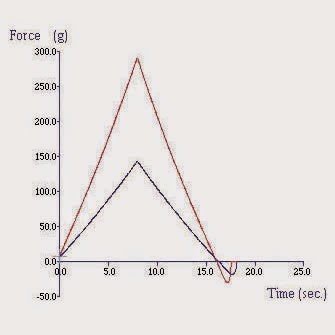 GELS (Bloom test):
GELS (Bloom test): P/0.5 - AOAC method;
P/0.5R - ISO method
XT/BL - Bloom jar
The measurement of gel strength is of widespread interest in the manufacture of pharmaceutical, medical and cosmetic products, and also in areas of the food industry such as confectionery.
Gel properties such as elasticity and rupture force of, for example, pectin, gelatine, agar etc. are important in the development of such products as coronary stents where hydrogel polymers are selected due to their soft, rubbery nature which gives them a strong, superficial resemblance to living, soft tissue.
 |
| Comparison of gel strength (‘bloom strength’) of two gelatine gels |

Other areas in which gel-forming properties are useful are the manufacture of wound dressings, jelly lubricants, contact lenses, suppositories, soft gel capsules and bacterial growth media. The strength of gels can also be utilised in products such as toothpaste, creams and pastilles to modify the consistency of the required end product.
Standard probes such as that required for gelatine testing (ISO or AOAC), as shown above, are available for the assessment of Bloom strength or rupture characteristics of gels.
Some more information on this fixture:
Measuring Gel Strength, Rupture Force and Elasticity
Using a Cylinder Probe (typically 1" radiused for pectin and 0.5" for other gel types), the probe is lowered into the gelled system at a fixed rate to a distance which does not lead to fracture of the gel surface. The strength of the gel is assessed as the peak force (i.e. the force to reach the chosen distance) or the force to penetrate to a smaller chosen depth.
Standard probes such as that required for gelatine testing (according to the ISO Standard) are also available for the assessment of Bloom strength or rupture characteristics of gels, where the force at 4mm penetration is taken as its Bloom value.
Should it be necessary to measure rupture force, gel brittleness/ elasticity, this test (for the determination of Bloom Strength) can be adapted to continue penetration after 4mm to e.g. 15mm into the Bloom jar. So long as the sample is prepared according to the standard and the Bloom value is taken from the curve at Distance = 4mm, the Force (Rupture Force) and Distance (Brittleness/Flexibility) at Rupture can also be obtained.
We can design and manufacture probes or fixtures for the TA.XTplus texture analyser that are bespoke to your sample and its specific measurement.
Once your measurement is performed, our expertise in its graphical interpretation is unparalleled. Not only can we develop the most suitable and accurate method for the testing of your sample, but we can also prepare analysis procedures that obtain the desired parameters from your curve and drop them into a spreadsheet or report designed around your requirements.
For more information on how to measure texture, please visit the Texture Analysis Properties section on our website.
 The TA.XTplus texture analyser is part of a family of texture analysis instruments and equipment from Stable Micro Systems. An extensive portfolio of specialist attachments is
available to measure and analyse the textural properties of a huge range of
food products. Our technical experts
can also custom design instrument fixtures according to individual
specifications.
The TA.XTplus texture analyser is part of a family of texture analysis instruments and equipment from Stable Micro Systems. An extensive portfolio of specialist attachments is
available to measure and analyse the textural properties of a huge range of
food products. Our technical experts
can also custom design instrument fixtures according to individual
specifications.No-one understands texture analysis like we do!
To discuss your specific test requirements click here...
|



No comments:
Post a Comment